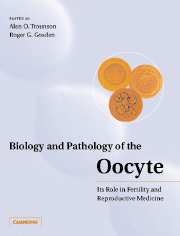Book contents
- Frontmatter
- Contents
- List of contributors
- Preface
- Part I Historical perspective
- Part II Life cycle
- Part III Developmental biology
- Part IV Pathology
- Part V Technology and clinical medicine
- 17 Growth and development of the mammalian oocyte-granulosa cell complex in culture
- 18 Human oocyte maturation in vitro
- 19 Follicular factors affecting oocyte maturation and developmental competence
- 20 Low temperature storage of follicular and ovulated oocytes
- 21 Fecundity of transplanted ovaries
- Index
17 - Growth and development of the mammalian oocyte-granulosa cell complex in culture
from Part V - Technology and clinical medicine
Published online by Cambridge University Press: 05 August 2016
- Frontmatter
- Contents
- List of contributors
- Preface
- Part I Historical perspective
- Part II Life cycle
- Part III Developmental biology
- Part IV Pathology
- Part V Technology and clinical medicine
- 17 Growth and development of the mammalian oocyte-granulosa cell complex in culture
- 18 Human oocyte maturation in vitro
- 19 Follicular factors affecting oocyte maturation and developmental competence
- 20 Low temperature storage of follicular and ovulated oocytes
- 21 Fecundity of transplanted ovaries
- Index
Summary
Introduction
Isolated oocytes do not grow in culture without their companion somatic cells, the granulosa cells. Their intimate and complex relationship extends from follicle formation to ovulation and affects the development and function of both cell types. Details of the necessity and nature of this relationship are just beginning to emerge and are gleaned primarily from experiments conducted in vitro. This chapter is devoted to these culture systems, the fundamental concepts derived from using them and the promise as well as the dangers of their practical application.
The challenge of making a good oocyte
Since the emergence of heterogametic reproduction, both gametes have provided haploid chromosomal complements, but one gamete, the egg, has borne the burden of supporting postfertilization development until the transition to zygotic gene expression and regulation is completed. This is not a simple challenge. Four obviously essential processes must occur during oocyte development: (1) meiosis; (2) growth and accumulation of maternal information and regulatory factors essential to support early embryonic development; (3) epigenetic modifications of the genome; and (4) preparation for fertilization and egg activation. Success in completing these processes results in the formation of an egg competent to participate in the generation of healthy offspring. Failure may produce infertility, genetic disease or even adult-onset illness. Thus, the challenge of producing a good oocyte in vivo is serious, but it is even more daunting in vitro.
Communication between oocytes and companion granulosa cells is a two-way conversation
Oocytes and oocyte-associated granulosa cells (OAGCs) communicate with each other via both gap junctions, a membrane specialization that allows the transfer of low molecular weight molecules, and secreted paracrine signals (Eppig, 1977; Eppig, 1979; Herlands and Schultz, 1984; Packer et al., 1994; Cecconi et al., 1996; Simon et al, 1997). OAGCs promote growth and development of the oocyte and acquisition of competence to resume meiosis. In addition, OAGCs maintain meiotic arrest in fully grown oocytes, participate in the induction of meiotic resumption after the preovulatory surge of luteinizing hormone (LH) (Eppig, 1991) and cooperate in the global termination of transcription in oocytes shortly before the induction of maturation (De La Fuente and Eppig, 2001). In turn, the oocytes promote the formation of primordial follicles (Soyal et al., 2000), granulosa cell proliferation and cumulus expansion, and they can regulate granulosa cell differentiation and function (Eppig et al., 1997a).
- Type
- Chapter
- Information
- Biology and Pathology of the OocyteIts Role in Fertility and Reproductive Medicine, pp. 273 - 282Publisher: Cambridge University PressPrint publication year: 2003
- 2
- Cited by



